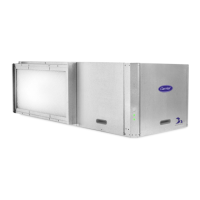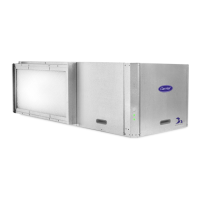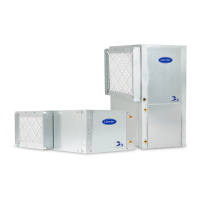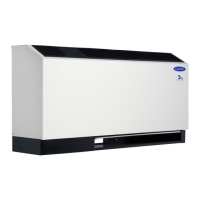34
Table 13 — Aquazone™ D Control Current LED Status and Alarm Relay Operations
LEGEND NOTES:
1. If there is no fault in memory, the Fault LED will flash code 1.
2. Codes will be displayed with a 10-second Fault LED pause.
3. Slow flash is 1 flash every 2 seconds.
4. Fast flash is 2 flashes every 1 second.
5. EXAMPLE: “Flashing Code 2” is represented by 2 fast flashes fol-
lowed by a 10-second pause. This sequence will repeat continually
until the fault is cleared.
SERVICE
Perform the procedures outlined below periodically, as
indicated.
Filters —
Filters must be clean for maximum performance.
Inspect filters every month under normal operating conditions.
replace when necessary.
Water Coil —
Keep all air out of the water coil. Check
open loop systems to be sure the well head is not allowing air
to infiltrate the water line. Always keep lines airtight.
Inspect heat exchangers regularly, and clean more frequent-
ly if the unit is located in a “dirty” environment. The heat
exchanger should be kept full of water at all times. Open loop
systems should have an inverted P trap placed in the discharge
line to keep water in the heat exchanger during off cycles.
Closed loop systems must have a minimum of 15 PSI during
the summer and 40 PSI during the winter.
Check P trap frequently for proper operation.
Condensate Drain Pans —
Check condensate drain
pans for algae growth twice a year. If algae growth is apparent,
consult a water treatment specialist for proper chemical treat-
ment. The application of an algaecide every three months will
typically eliminate algae problems in most locations.
Refrigerant System —
Verify air and water flow rates
are at proper levels before servicing. To maintain sealed circuit-
ry integrity, do not install service gauges unless unit operation
appears abnormal.
Condensate Drain Cleaning —
Clean the drain line
and unit drain pan at the start of each cooling season. Check
flow by pouring water into drain. Be sure trap is filled to main-
tain an air seal.
Air Coil Cleaning —
Remove dirt and debris from evap-
orator coil as required by condition of the coil. Clean coil with
a stiff brush, vacuum cleaner, or compressed air. Use a fin
comb of the correct tooth spacing when straightening mashed
or bent coil fins.
DESCRIPTION
STATUS LED
(Green)
TEST LED
(Yellow)
FAULT LED (Red) ALARM RELAY
Normal Mode
On Off Flash Last Fault Code in Memory Open
Normal Mode with PM
On Off Flashing Code 8
Cycle (closed 5 sec,
open 25 sec, …)
D Control is non-functional
Off Off Off Open
Test Mode
— On Flash Last Fault Code in Memory Cycling Appropriate Code
Night Setback
Flashing Code 2 — Flash Last Fault Code in Memory —
ESD
Flashing Code 3 — Flash Last Fault Code in Memory —
Invalid T-stat Inputs
Flashing Code 4 — Flash Last Fault Code in Memory —
No Fault in Memory
On Off Flashing Code 1 Open
HP Fault
Slow Flash Off Flashing Code 2 Open
LP Fault
Slow Flash Off Flashing Code 3 Open
FP1 Fault
Slow Flash Off Flashing Code 4 Open
FP2 Fault
Slow Flash Off Flashing Code 5 Open
CO Fault
Slow Flash Off Flashing Code 6 Open
Over/Under Voltage
Slow Flash Off Flashing Code 7 Open (closed after 15 minutes)
HP Lockout
Fast Flash Off Flashing Code 2 Closed
LP Lockout
Fast Flash Off Flashing Code 3 Closed
FP1 Lockout
Fast Flash Off Flashing Code 4 Closed
FP2 Lockout
Fast Flash Off Flashing Code 5 Closed
CO Lockout
Fast Flash Off Flashing Code 6 Closed
CO —
Condensate Overflow
ESD —
Emergency Shutdown
FP —
Freeze Protection
HP —
High Pressure
LP —
Low Pressure
PM —
Performance Monitor
IMPORTANT: When a compressor is removed from this
unit, system refrigerant circuit oil will remain in the com-
pressor. To avoid leakage of compressor oil, the refrigerant
lines of the compressor must be sealed after it is removed.
IMPORTANT: All refrigerant discharged from this unit
must be recovered without exception. Technicians must fol-
low industry accepted guidelines and all local, state and fed-
eral statutes for the recovery and disposal of refrigerants.
IMPORTANT: To avoid the release of refrigerant into the
atmosphere, the refrigerant circuit of this unit must only be
serviced by technicians which meet local, state and federal
proficiency requirements.
IMPORTANT: To prevent injury or death due to electrical
shock or contact with moving parts, open unit disconnect
switch before servicing unit.
IMPORTANT: Units should never be operated with-
out a filter.
To avoid fouled machinery and extensive unit clean-up,
DO NOT operate units without filters in place. DO NOT
use equipment as a temporary heat source during
construction.

